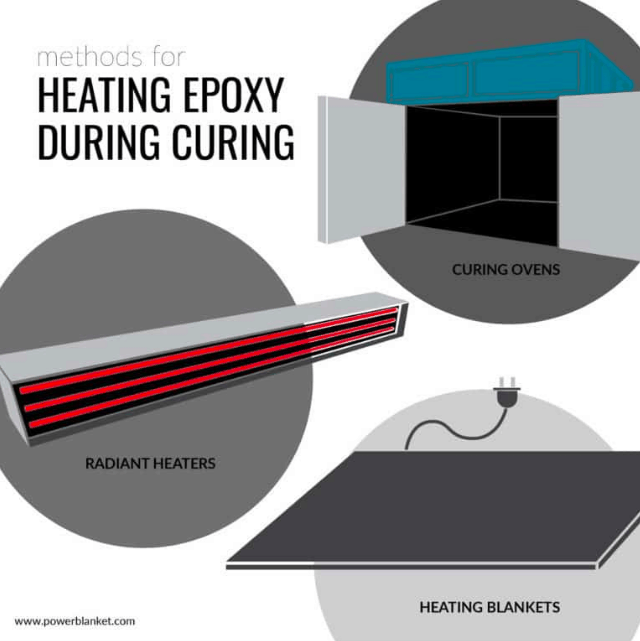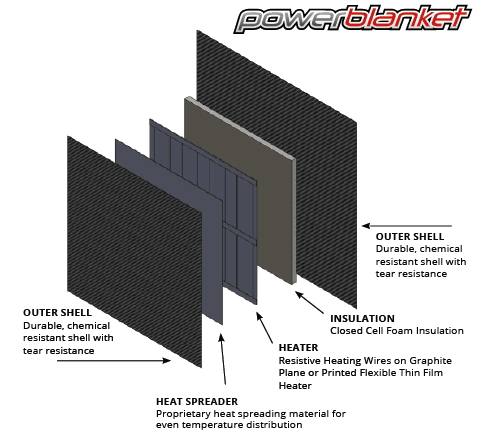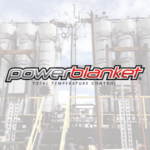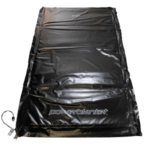Epoxy resins need proper heat care to cure effectively. What options are available to ensure heat is applied correctly in all parts of the curing process?
Using Heat in Epoxy Curing

Is it necessary to have evenly distributed heat for curing epoxy resins? The simple answer is yes. If you are using heat to cure something, having even heat distribution will cure or heat the product evenly. If heat isn’t distributed evenly, only part of the product will cure while other parts will remain uncured. Curing epoxy in this manner is doable, however, it is not recommended.
Let’s consider a common heat method for a minute, heat trace (localized heat). Heat trace is strung out along the material and only heats what it rests upon. Will it get the object hot? Sure. Will it heat the entire surface to the same temperature, regardless of the placement of the heater? No. It will have hot and cold spots.
Powerblanket Solutions
Now let’s consider an alternative heating method, Powerblanket’s technology. If you were to place a Powerblanket over the top of an object, it will heat evenly across the entire blanket. The difference is that unlike heat trace, the blanket disburses the same amount of heat simultaneously across the surface of the blanket. This heating method drives the same amount of heat into the substance being heated.
Powerblanket versus Common Heat Source
Powerblanket is vastly superior than your everyday heating sources and is the best way to cure resin. Don’t believe us? Try using other heat sources to provide evenly distributed heat and see if the results are the same.
Cookies
Let’s take a cookie for an example, because that should be something we all understand: cookies must be baked evenly without any burns. If you placed heat trace on cookie dough and turned it on for a few minutes, you would have a partial cookie surrounded by dough on both sides. That’s gross and probably unsanitary. If you kept the heat trace on, in an effort to cook the entire cookie, you would eventually cook the entire cookie however, you would have blackened and burnt sections where the heat trace tape was laid. Also gross, and a waste of good cookie dough.
But what if we used a propane torch or another open flame source of heat? Wouldn’t that provide enough heat and cover the cookie completely? While heat would cover the cookie, open flame is an unreliable heat source due to its inconsistency in spreading heat evenly and in maintaining specific temperatures.
An oven would obviously be a great choice, but these are bulky and expensive. Good luck dragging one of these to every place you want to bake cookies at.
If you took the same amount of dough and placed a Powerblanket on top of it, it would cook the cookie evenly (if they could get warm enough to bake). There would be no burned spots and doughy spots. Now that’s a cookie worth eating.
The Need for Even Cure Speed 
Epoxy needs to cure in a manner similar to a cookie, with evenly distributed heat. This is especially critical during the post curing phase of the epoxy resin curing process, where temperatures must be kept above 212° F for at least four hours. This is to ensure that any moisture remaining in the epoxy resin is evaporated away, resulting in a hardened epoxy that is water tight and ready for use.
Just as with a cookie, you can’t cure part of an epoxy resin. It’s either all at the same time or none at all. Curing part of an epoxy resin will result in a mess of gloppy, melting resin with hardened slabs of epoxy. It’s completely unusable and will need to be thrown out as wasted material, costing you money and setting you back in time and energy.
Outgassing
Outgassing is a potentially dangerous side affect of some epoxy adhesives. Outgassing is when materials, such as epoxy products, give off gasses that were trapped within the epoxy resin during the curing phase until exposed to certain environments, such as in a vacuum. The gasses can them form condensation on electrical equipment, causing more problems.
According to Master Bond, a manufacturer and retailer of epoxy adhesives, some epoxy adhesives “are designed to prevent contamination that can reduce device functionality.” In addition, “optical products can be clouded/fogged by outgassed chemical compounds. Electronic/semiconductor processing can be sensitive to outgassing materials. Vacuum processing can also be adversely affected by use of non compliant adhesives.” Groups like NASA require epoxy products to have a low outgassing rating to minimize the amount of moisture buildup in order to protect sensitive electronics and prevent optical lenses and windows from fogging up.
If your epoxy resins and adhesives will be used in special environments, particularly those where outgassing could pose a serious problem, make sure that the epoxy you’re using won’t bleed gasses that might cause issues later on and that could compromise your project.
Heat Management in Epoxy Storage
It should be noted that storing epoxy resins also requires controlled temperatures, otherwise the epoxy can be disturbed enough to impact cure time later on when used.
Ideal temperatures for storing epoxy resins should be between 65° F and 90° F. The area you are storing the epoxy in should be dry and free from sources of moisture, which could infiltrate the epoxy container and contaminate the epoxy resin. Doing these things will help prevent problems when your epoxy is curing in future projects.
Consequences of Improper Curing
Heat tape will result in uneven curing. Open flame leads to inconsistent heating temperatures. Epoxy curing ovens are troublesome to operate and expensive to obtain, especially for smaller businesses. All of these can lead to uneven curing. An uneven cure of epoxy can have the following negative consequences:
- Discoloration/Yellowing
- Color Variation
- Blushing
- Uneven Gloss
- Poor Inter-Coat Adhesion
There is only one solution to maintaining high temperatures during the epoxy resin post curing process: epoxy curing blankets.
Heating Blankets in Epoxy Curing 
Epoxy curing blankets provide even, consistent heat at preset temperatures. Powerblanket manufactures the best heating blankets available on the market, which are perfectly suited to epoxy resin curing heating requirements as well as storing epoxy. Certified by ETL to UL and CSA safety standards, these blankets are easy to use and ready for operation upon delivery. Layers of insulation help the blankets operate in direct contact with the materials they’re heating, which helps prevent heat transfer waste.
For more information about how heating blankets can help control temperatures in epoxy curing and storage, contact our heating blanket specialists at 855.402.9860 or by email at [email protected].
Cure your epoxy resins faster and easier than ever before with Powerblanket.







